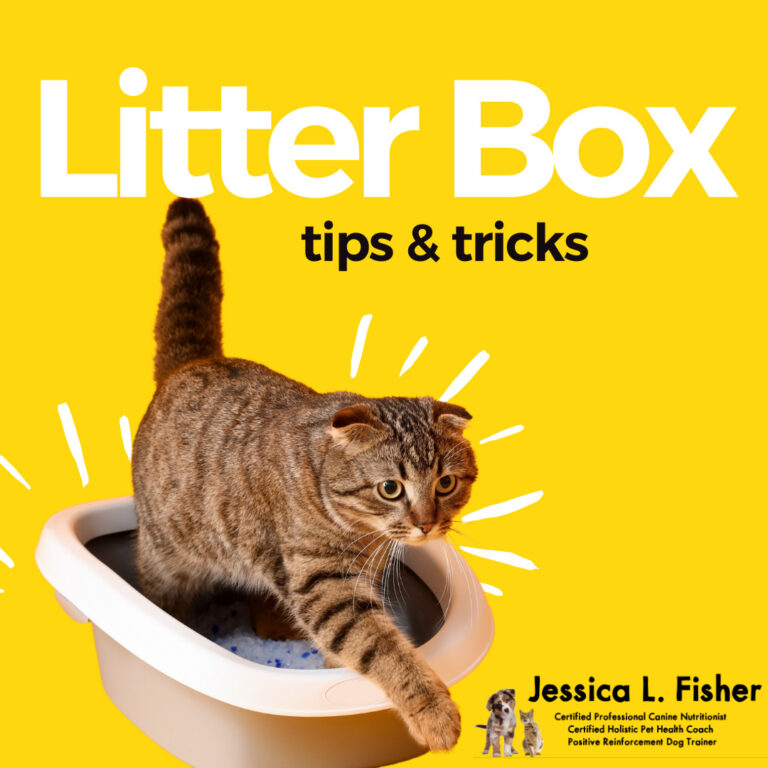Call me a weirdo if you like, but I have spent many years figuring out cat litter, litter boxes, what works, what doesn’t, what my cats like, what they don’t, what to add, what to leave out… the list goes on and on. You might even say I’m overly concerned with my cat’s litter boxes, but I think you might not be concerned enough!
I’ve created a handful of videos on the topic over the years, which I will link at the bottom of this post, but I wanted to put it all together in one place.
What’s the #1 rule of cat litter (insert Brad Bitt from Fight Club)? Your cat is the deciding factor. Period. What’s the point if your cat won’t use it?
Point in case, my top choice for cat litter is Weruva’s It’s A Tea Potty! cat litter, but only one of my cats will use it, so I had to find something else that fit my criteria as best as it could and also that my cats will use it.
Choosing A Litter
When choosing a cat litter, I’m looking for something as natural as possible that also provides any or all of the following: clumping (or pellet), no fragrances, no corn, no wheat, no soy, and nothing that has me wondering what it’s actually made of.
I’ve tried so many litters over the years. For a while, I even used corn-based litter. What?! I don’t know what it is, but for some reason, I (and many others) figure things out based on our dogs and slowly the lightbulb turns on with our cats too.
I’m trying hard to adjust this type of thinking. If I learn something for the sake of my dog (or myself) I ask myself how this applies to everyone in my home, including my cats.
It’s important to be as aware of what is in your cats litter as you are of what is in their food because SURPRISE! cats ingest litter. It’s not ideal, but if litter or litter dust is on their fur, they clean it off just as they clean their body any other time, by using their tongue.
As I said, I would prefer Weruva’s litter, but since only one of my cats will use it, I had to make a choice on what to try next. I tried litter made from coconut and while it was great for the environment, it smelled terrible quickly and didn’t clump very well.
I considered using dirt at one time, but feel the same would be true.
We currently use an all-natural clumping grass-based cat litter.
Litter boxes
Litter boxes are another area that people don’t spend enough time considering.
First, let’s talk about how many boxes you should have. As a general rule, you should have one box per cat plus one. So if you have one cat, you should have two boxes. If you have 4 cats, as I do, then you should have 5 boxes.
What type of box also matters.
Jae and Adrienne of The Two Crazy Cat Ladies like using large rubbermaid storage containers where they cut an entrance into one of the sides. From what I can tell they leave the lid off (at least I hope so!)
They like the large storage bins because they are long enough. Most litter boxes just aren’t long enough for your cat to comfortably fit in.
I still use regular litter boxes but I do buy the largest ones I can find. I also give my cats options, so some of them are a regular height all the way around. I also have some high-sided boxes but Romeo will not entertain using those.
Again, it’s mostly about what your cat will use.
Cats are very sensitive to smells, so enclosed boxes are a big no-no!
I also do not recommend robot litter boxes. Cats are very good at hiding when they don’t feel well, so as their guardian, you need to be aware of what’s going on in the litter box. How often does your cat pee? How often do they poop? What’s the color? What’s the consistency? Changes in color, smell, consistency, and frequency could be cause for concern and a visit to the veterinarian!
Litter box placement
We’ve already talked about your cat’s sensitivity to smells, so if you think that putting the litter box in the closet or laundry room is a good idea, I’d ask you to reconsider.
Your cats’ box should be in a well-ventilated area, but somewhere that is out of the way and not in a high-traffic area of your home. Just like you don’t want everyone in the house looking at you or walking by when you use the toilet, your cat doesn’t either.
If you have a multi-cat household it’s also a good idea to separate some of your litter boxes. Some cats can become territorial and possessive over a litter box, so by separating them into different areas your cats will have the opportunity to use a litter box in peace. This may seem inconvenient, but it is much more convenient than having a cat inappropriately eliminate outside of the box because another cat won’t let them use it!
Cleaning the box
Here’s the deal with cleaning the litter box… would you want to use a dirty toilet? NO! Your cat doesn’t want to use a dirty litter box either. I’m not sure if you’ve ever noticed, but many cats will pee in one litter box and poop in another. I have a cat who will not use the litter box again until it’s cleaned, and he’s not the first cat I’ve had to prefer a clean box.
If I see that a box has been used, I clean it. 5, 4, 3, 2, 1 … just get it done! Of course, when I’m away from the house or sleeping at night, this doesn’t happen, but cleaning the boxes is one of the very first things I do in the morning, anytime I return home, and one of the last things I do before bed at night.
But cleaning the litter boxes doesn’t end with scooping regularly. We also have to keep the litter level up (usually about halfway), so adding in fresh litter regularly is a must!
And litter boxes are generally plastic, so they need to be completely emptied, washed, and cleaned regularly. Most cat behaviorists will tell you to do this weekly. If I’m honest, I do it every 2-4 weeks depending on my schedule.
To do this, I empty all the old litter and throw it away. I then let the litter box soak in a mixture of hot water and white vinegar for about 30 minutes. I only do 1 box at a time so that my cats always have boxes to use.
If necessary, I can take a small amount of dish detergent and a microfiber cloth to scrub any areas that need extra attention. Rinse the box, dry it completely and refill with fresh, clean litter!
And because plastic isn’t made to last forever, litter boxes need to be completely changed (meaning buy new ones) every year. I just replaced all of mine about a month ago.
If your cat is very finicky, you may want to change them one at a time so they have time to adjust before changing the next one.
Extra touches
You know me, I have to mention animalEO every chance I get! I love using the Litteroma line of essential oils with baking soda in my cats’ litter boxes.
There is a Litteroma All Cat, but there are also Litteroma’s designed specifically for cats with varying illnesses, such as Litteroma Kidney Cat and Litteroma Smelly Cat.
Dr. Shelton recommends the following for use:
“Start with unscented kitty litter – staying within the same brand that you currently use is often advisable. Add 1-3 drops of your chosen animalEO essential oil single or blend to 1 cup of baking soda – store this mixture within a glass jar, and allow it to “marinade” and blend overnight, shaking the mixture several times. Later, you may find you can add more essential oil drops to this recipe. Starting with a small portion (maybe 1 Tablespoon) – sprinkle the baking soda mixture onto your kitty litter. Mix well. Provide a separate litter box that does not contain essential oils, to make sure that your cat does not have an aversion to the essential oil that was selected. Once you are sure your cat is using the litter box with your oil selection and concentration, you can then omit the use of the “plain” litter box. Each time you scoop, you can sprinkle a bit more Litteroma into your box to freshen it up!”
Do you have any tips to add to the list? I’d love to hear it!




